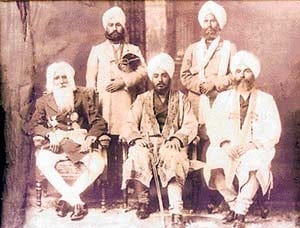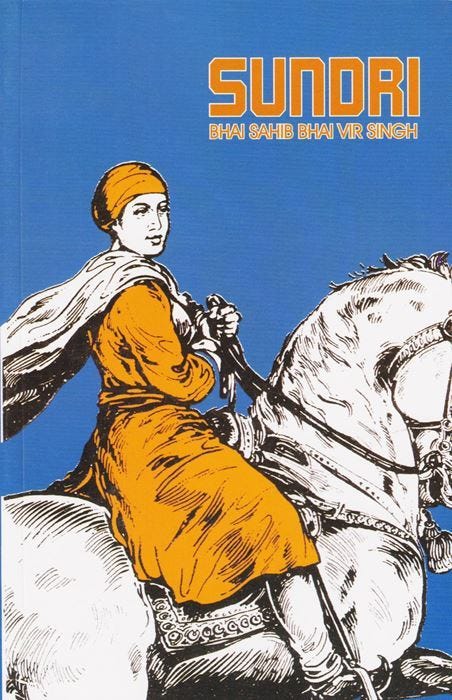Must-read Singh Sabha literature
A list of various Singh Sabha books that have had a large influence on Sikh scholarship
Whether through a reformist or Sanatan lens, Singh Sabha ideologues changed the framework of how Sikh theology, jurisprudence and history operated for future generations, resulting in a renaissance of Sikh literature. With any in-depth reading of Sikhi, Singh Sabha texts eventually become imperative to read thus this list was compiled of important books that innovated Sikh literary culture.
Katak Ke Vaisakh - Karam Singh Historian
Karam Singh Historian’s book covers the dilemma of Guru Nanak’s birthday, giving ample evidence for it being in the month of Vaisakh (April to May) rather than Katak (October to November). He proved that other accounts of Janamsakhis, with the exception of Bhai Bala Janamsakhi, give accounts for Guru Nanak’s birthday being in Vaisakh. This book also offered the first critique of the Bhai Bala Janamsakhi being an illegitimate source and paved the way for modern discussion on whether Bhai Bala existed or not. Later on, Giani Ishar Singh Naara wrote ‘Vaisakh Nahi Katak: Guru Nanak Avtar’, to counter the claims made by Karam Singh Historian.
Sadhu Dayanand Te Mera Samwad - Giani Ditt Singh
Sadhu Dayanand Te Mera Samwad is a written account of the philosophical debate between the Arya Samaj founder Swami Dayanand Saraswati and the Singh Sabha stalwart Giani Ditt Singh, written exclusively in metre with dohras and swaiyyas. It is quite a difficult text to read for beginners and is definitely suited for those with a larger understanding of Punjabi vocabulary and other motifs. As a book, it represents the large-scale schism between the various Singh Sabhas and Arya Samaj that took place in the late 19th century.

Twarikh Guru Khalsa - Giani Gian Singh
Twarikh Guru Khalsa is the five volume collection of Giani Gian Singh on Sikh history, split up from the history of the Gurus to the annexation of Punjab by the British, other Sikh states and Sikh sects. Giani Gian Singh made use of his Amritsar Singh Sabha colleagues and later allowed the Khalsa Tract Society of Amritsar to publish his works. Twarikh Guru Khalsa and Naveen Panth Prakash are both amongst the most important works he’d published. Unfortunately, the fourth volume Sardar Khalsa was never published but often the first three volumes on history are able to be found.
Mahan Kosh - Kahn Singh Nabha
The Mahan Kosh is Kahn Singh Nabha’s magnum opus, taking fourteen years in order to complete. This was the first Punjabi encyclopaedia, containing over 60,000 words from all over Punjabi, with theological, historical and local words compiled in alphabetical order. This work was created in order to promote Punjabi and Sikh studies both, containing etymologies from both Persian and Sanskrit. The Mahan Kosh was patronised by the ruler of Patiala, Maharaja Bhupinder Singh, who took up all the expenses of printing. Later on, this would play a large role in influencing scholarship and is still used to this date, as an important reference.
Sundari - Bhai Vir Singh
Bhai Vir Singh’s novel Sundari was amongst of the first novels written in Punjabi. The story is of the protagonist Sundari who becomes Sikh, in her fight against the Mughals. The novel was an attempt to rebuild a Sikh artistic tradition albeit in a modern light. Bhai Vir Singh, as one of the main figures of the Singh Sabha movement, used the novel to build a narrative of Sikh heroism across North India, and ultimately helped shape modern Punjabi literature.
Khalsa Dharam Shastar - Avtar Singh Vahiria
Avtar Singh Vahiria’s work Khalsa Dharam Shastar was an attempt by the more Sanatan strands of the Singh Sabha to counter claims made by Singh Sabha reformists, patronised by the Sodhis of Anandpur Sahib. This work was created as a unified code of conduct and manual for various ceremonies, he frequently quotes other rehitnamas, Suraj Prakash and other previous literature. The intent behind Khalsa Dharam Shastar was to preserve traditional Sikhi against excessive reformism, debating reformist Singh Sabha literature on topics of caste, women and clerical nobility and due to this, it gained a controversial reputation amongst later Sikh scholars.
Hum Hindu Nahin - Kahn Singh Nabha
Kahn Singh Nabha’s classic treatise was written in response to Sanatanist (both Hindu and Sikh) and Arya Samaj claims that Sikhs were a mere sect in the larger Hindu religion. The book was written after the Dyal Singh Majithia case, in which his wife appealed to claims that he was a Hindu by religion, not a Sikh. In the aftermath of this case, Bawa Narain Singh wrote a treatise called ‘Hum Hindu Hain’ to prove Sikhi was indeed part of larger Hinduism. Kahn Singh Nabha’s retort of ‘Hum Hindu Nahin’ helped cement Singh Sabha narrative as a Sikh theological framework distinct from the traditional Udasi and Nirmala frameworks requiring Vedanta and became arguably the most popular book from the Singh Sabha, resulting in a large ideological shift.

Jhatka Parkash - Giani Niranjan Singh Saral
Even though this book was written during the 1960s, a post-Singh Sabha era, the arguments put forward by Giani Niranjan Singh Saral were based on Singh Sabha principles. Jhatka Parkash was written as a rebuttal to Randhir Singh’s Jhatke Prithaye Tat Gurmat Nirney, an anti-jhatka treatise. Jhatka Parkash defended the consumption of jhatka meat on ethical, theological and historical logic. The book was promoted by various Nihang dals and the SGPC, in an attempt to renormalise consumption of jhatka meat amongst Sikhs again; even Akali Dal candidates such as Darshan Singh Pheruman and Parkash Badal sponsored the publishing of Jhatka Parkash.





Are there pdf copies available online for all the books mentioned above?
Are these available in English?